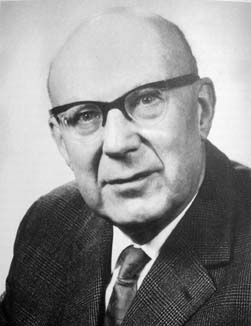
George Frederick James Temple
 المؤلف:
C W Kilmister
المؤلف:
C W Kilmister
 المصدر:
George Frederick James Temple, Bull. London Math. Soc. 27
المصدر:
George Frederick James Temple, Bull. London Math. Soc. 27
 الجزء والصفحة:
...
الجزء والصفحة:
...
 18-9-2017
18-9-2017
 982
982
Born: 1 September 1901 in Kensington, London, England
Died: 30 January 1992 in Quarr Abbey, Isle of Wight, England

George Temple's father was James Temple (born in Somerton, Oxfordshire about 1846) who was a railway inspector. His mother was Fanny Temple (born in Broadwell, Oxfordshire in 1857).
George Temple was educated in London. In 1918 he entered Birkbeck College as an evening student (the College had previously been known as London Mechanic's Institution and in 1920 was recognised as a school of the University of London for evening and part-time students). George became a part-time research assistant in physics there the following year. He received his B.Sc. in 1922, then two years later he was appointed Demonstrator in Mathematics at Imperial College, London.
Whitehead had been the main reason for Temple's move to Imperial as he had been interested in papers in relativity which Temple had published. However Whitehead left the chair at Imperial as Temple arrived and Chapman was appointed to fill the chair. Chapman obtained a scholarship for Temple to undertake further research and he spent a year at Imperial working on quantum theory before going to Cambridge where he worked with Eddington.
He married Dorothy Lydia Carson on 2 September 1930 in the Church of St Agnes, West Kirby, Cheshire. She was born 26 April 1899 in Toxteth Park, Liverpool, Lancashire.
Temple returned to Imperial as a Reader in 1930, then two years later was appointed to the chair of mathematics at King's College London. During World War II he worked at RAF Farnborough where his work earned him a CBE. During his time in Farnborough he worked on aerodynamics and supersonic fluid flow.
After 1945 Temple returned to King's College. He advised the Minister of Civil Aviation on air traffic control during 1948-50. In 1953 Temple moved to the Sedleian chair at Oxford to succeed Chapman.
Temple worked on a wide variety of topics. Relativity theory, aerodynamics and quantum mechanics have been mentioned above but he also worked on analysis contributing to the study of the Lebesgue integral.
He wrote seven books, two on quantum theory An introduction to quantum theory (1931) and The general principles of quantum theory (1934). His other books included An introduction to fluid dynamics (1958) and The structure of the Lebesgue integration theory (1971).
In 1981 (at the age of 80) he published a book on the history of mathematics. This book 100 years of mathematics (1981) took him ten years to write and deals with, in his own words:-
those branches of mathematics in which I had been personally involved.
He declared that it was his last mathematics book, and entered the Benedictine Order as a monk. He was ordained in 1983 and entered Quarr Abbey on the Isle of Wight. However he could not stop doing mathematics and when he died he left a manuscript on the foundations of mathematics. He claims:-
The purpose of this investigation is to carry out the primary part of Hilbert's programme, i.e. to establish the consistency of set theory, abstract arithmetic and propositional logic and the method used is to construct a new and fundamental theory from which these theories can be deduced.
Temple was elected a Fellow of the Royal Society in 1943 and, in 1970, he was awarded the Sylvester Medal of the Society:-
... in recognition of his many distinguished contributions to applied mathematics, especially in his work on distribution theory.
He was President of the London Mathematical Society during the period 1951-53.
Articles:
- C W Kilmister, George Frederick James Temple, Bull. London Math. Soc. 27 (1995), 281-287.
- C W Kilmister, George Frederick James Temple, Biographical Memoirs of Fellows of the Royal Society of London 40 (1994), 383-400.
- In memoriam - George Frederick James Temple, Modern Logic 3 (1993), 161-163.
 الاكثر قراءة في 1900to1904
الاكثر قراءة في 1900to1904
 اخر الاخبار
اخر الاخبار
اخبار العتبة العباسية المقدسة


